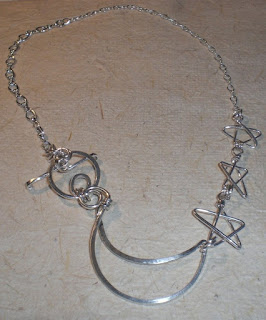
I've been reading a lot on chainmaille; never thought I'd be so addicted to this ancient technique. It's a science all on its own.
So here's my 2nd chainmaille project. I learned this weave is called King's maille. Out of so many weave patterns, this caught my eye again and again for those big double rings. Yesterday, I set out to test it, tried several gauges, finally settled on 16 ga (all 8.5 feet of it!) with 10 mm ID. The toggle and the rosette counter-weight are both 14 ga, and the various connector rings are from 18 ga to 14 ga, all handmade. Final length is 7 1/4" and 1" wide.

It fits on my right wrist perfectly, lays flat when I rest my hand on a desk, and doesn't flop around too much.

I'm very pleased. Also tried threading in the toggle bar from the front and the back; definitely treading from the back produces a smoother look, although the counter-weight is not always effective, maybe it can be a bigger rosette. But all in all, it came out pretty much like what I expected.
Then I took out my first chainmaille bracelet to compare to this new bracelet, just to see if I have improved, or not. That's when I noticed something:

Duh! They're the same weave! Do you see that? The main difference between the two are the sizes and shapes of rings. What a revelation for me! I've read that the Aspect Ratio is the most critical part of chainmaille, but this time, it's really sinking in. It's a lot like bead weaving where the same stitch when used with different sizes and shapes of beads, can mutate into a whole new look! Boy, I learned something new (kind of) today!
Check out more images
here.
 A few days ago, I made a flower knot, or at least that's how I saw it, since it's more cushy than a flower weave, making it more of a knot. Any way, today, I came across this page (scroll down to end of web page) on a chainmaille site which says there's a name for this little flower. It's called a "mobius ball" and the web page mentioned this is a "patented" weave. Not sure what that means... I never saw that web page before making this flower knot (yes, I call it a flower knot); as far as I know, this is just a version of the good old flower/rosette weave, what's there to patent about? Is there a patent for the flower weave?
A few days ago, I made a flower knot, or at least that's how I saw it, since it's more cushy than a flower weave, making it more of a knot. Any way, today, I came across this page (scroll down to end of web page) on a chainmaille site which says there's a name for this little flower. It's called a "mobius ball" and the web page mentioned this is a "patented" weave. Not sure what that means... I never saw that web page before making this flower knot (yes, I call it a flower knot); as far as I know, this is just a version of the good old flower/rosette weave, what's there to patent about? Is there a patent for the flower weave?









